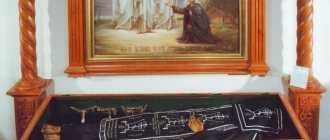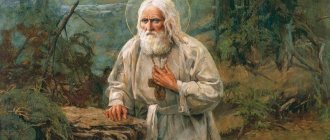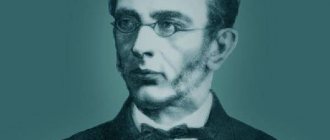Alexandra Diveevskaya: how to found a good monastery
Venerable Alexandra Diveevskaya. The novice Evdokia described her mother’s appearance this way: “Her eyes were gray, her nose was short like a bulb, her mouth was small, her hair was light brown in her youth, her face and arms were full.” Image from mariya-myronenko.com
A beautiful woman with means, leaving everything for the love of God, took monastic vows, left her home for the wilds and wilderness, cleaned barns, washed peasant children, washed monastic footcloths, built churches, prayed and took her time.
After 20 years, a small community of women striving for God arose under her leadership. They were entrusted to a man who, in his nightmare, never dreamed of “leading” the nuns. But he promised to take care of them out of obedience to his confessor, whom he loved very much, and his dying promise to the founding mother, whom he called “a great saint.”
True, he was in no hurry either. Before raising nuns, he spent 25 years in seclusion, educating his soul. He came out as a famous old man - Seraphim of Sarov. By that time, 50 sisters had gathered in the community of M. Alexandra.
By sign from above
View of the Kiev-Pechersk Lavra from the other bank of the Dnieper. Image from co6op.narod.ru
Agafya Semenovna Melgunova (1720 - 1789) was not even 20 years old when she was left a widow with an infant child and considerable wealth. Not knowing how to live further, she went to Kyiv, to the Kiev Pechersk Lavra, and spoke with her confessors. The fathers, despite her youth, saw a mature person in front of them and blessed her to become a monk. Agafya took monastic vows at the Florovsky Monastery and wanted to stay there.
But one day I heard the words of the Mother of God: “Go north and go around all the Great Russian places of My monasteries and there will be a place where I will show you where to end your godly life, for in your place of residence I will establish My monastery.”
Having received the Mother of God’s order, she could have immediately gone to fulfill it, but Alexander’s mother was, as the future will show, a very sober person. Realist. She told about her vision not only to her spiritual father, but also to several other fathers of the Kiev Pechersk Lavra, known for their experience. After much prayer, the fathers recognized the appearance of the Mother of God as true.
But since the time for the Church was difficult, reformist, many monasteries were “shrinking” by decree of Catherine II (about 500 monasteries were closed - more than half in the country, and requests to create new ones were rejected, monks were strictly forbidden to “wander”), the fathers advised Alexandra to time to hide my monasticism and take care of business as a wealthy landowner Melgunova. The advice of the Kyiv fathers completely justified itself.
And M. Alexandra remained a secret nun almost all her life and was called Agafya Semyonovna. Only shortly before her death she will be tonsured into the schema with the same name - Alexandra.
Factories, noise and fights in Diveevo
The oldest image of the Sarov Desert, dating back to the mid-18th century. Image from sarpust.ru
It took M. Alexandra several years to find a place for the monastery in northern Russia. In 1760, she found herself near the village of Diveeva. There the Most Holy Theotokos appeared to her again: “This is the very place that I commanded you to look for. Live here and please the Lord God, and I will always be with you.”
M. Alexandra went to Diveevo and was horrified. In the village there was terrible noise from the work of iron factories, in the evenings there were a lot of drunks and hooliganism, fights, even robberies. How to build a monastery?
And again, as in Kiev, she found help from the fathers of the Sarov Hermitage, which at that time was considered the abode of ascetics (many Sarov fathers refused the priesthood, one even refused the episcopal title, just to maintain a prayer life in solitude).
The Sarov fathers advised M. Alexandra to settle in the village of Osinovka, two miles from Diveevo. And again the advice justified itself: soon one local landowner refused him land for a monastery.
And then M. Alexandra’s ten-year-old daughter fell ill and died. For her, this becomes a sign of a final break with the world. She goes home to sell the estate and dispose of the property: she frees the peasants and provides for many poor people.
Part of the money from the sale of the estate is given to the construction of churches, contributions to monasteries, and part is left for the future monastery. With her funds, more than 12 churches were built and restored, including the Assumption Cathedral of the Sarov Hermitage.
The work of a nun is a secret grace
Image from website moneta-russia.ru
In Osinovka, M. Alexandra settles with the parish priest Vasily Dertev (very respected in Sarov), having built himself a separate house. She spends the next 20 years there. A former landowner, the colonel cleans the barn at Fr. Vasily (helping the elderly priest), looks after his cattle, washes his clothes.
When the busy time of harvesting came and all the adults went to the field for whole days, Alexandra’s mother went to the houses where the children remained without parental supervision, lit the stoves, baked bread, cooked food, washed the children, changed their clothes and washed dirty linen. She really asked that the children not say who was helping them.
When the family was in dire need, she secretly left money. She secretly gave dowries to poor brides.
With her own hands, M. Alexandra embroidered festive headdresses - magpies and towels - as gifts for brides from poor families.
In my cell
The small house had two rooms and two closets. In one of the closets near the stove there was a small bed made of bricks, near which there was very little space. The other closet was dark, without windows: it served as a chapel for Mother Alexandra. Only mother herself could fit in it. She prayed here in front of a large Crucifix with a lit lamp.
M. Alexandra treated herself strictly: fighting against effeminacy, in defiance of her elegant upbringing, she wore a stiff hair shirt under her clothes, which chafed her skin. In winter and summer I wore the same clothes. Mother often had headaches, so she always wore a hat trimmed with hare fur. She had bast shoes on her feet; only in her old age did a benefactress give her light boots, and Alexander’s mother accepted them.
Pugachev near Sarov
Portrait of Emelyan Pugachev, painted over the portrait of Catherine II. Unknown artist, 1773. Image from mediashm.ru
At the place where, not far from Diveevo, the Most Holy Theotokos appeared to her, Mother Alexandra began to build a stone church in honor of the Kazan Icon of the Mother of God.
At this time there was a crop failure and famine in Diveevo. M. Alexandra involved local children in the construction of the temple. She asked them to bring bricks to the bricklayers. After work, mother fed the children and gave them a salary - a nickel each.
The construction of the temple coincided with the Pugachev riot. People were dying, there was chaos and unrest. In 1774, Pugachev took the city of Temnikov and was not far from Sarov. M. Alexandra asked the Mother of God to remove danger from the places where her monastery was being built. And again she had the answer: the war would pass her village. After some time, Pugachev’s troops stopped.
Woman in church
When the Sunday service ended, Mother Alexandra went out to the square near the church and preached. According to the stories of clergy from the Diveevo Chronicle, St. Serafima (Chichagova),
“She was smart, as men rarely are. She knew better than all the clergy in the area all the charters and regulations of the church.
They turned to Mother Alexandra for advice and instructions, and if a temple was illuminated somewhere, they asked Mother Alexandra to be the manager so that everything would go according to order and there would be order. A lot of people came and it seemed impossible to do without fuss and confusion, but M. Alexandra arranged everything in the best possible way: the church ceremony itself, the refreshment after the illumination of the temple, the reception of guests, etc.”
The beginning of the monastery
Diveevo, 1876. Image from sarpust.ru
Only six months before his death, what became the beginning of the Diveyevo Monastery arose. One of the landowners of the village of Diveeva gave M. Alexandra a large plot of land next to the temple. M. Alexandra built three cells and surrounded them with a fence. She lived in one cell herself, in another the pilgrims going to Sarov stayed overnight, and in the third she invited novices to live, among whom were an orphan and widows of peasant origin.
They lived according to the strict Sarov rules. In addition to prayer and alms, the sisters and mother sewed, knitted, and washed for the monks of Sarov. And food was brought to the sisters every day from the Sarov refectory.
Before her death, Mother Alexandra adopted the schema. She asked Fr. Pakhomiy (Nazarov), the abbot of Sarov, took care of her sisters. Elder Pachomius responded to her requests: “Mother, I don’t give you my word, for I am old and weak, but how can I take on this, not knowing whether I will live to see that time. But Hierodeacon Seraphim - you know his spirituality, and he is young - will live to see this; entrust this great task to him.”
Saint Seraphim about Mother Alexandra
Venerable Seraphim of Sarov. Unknown artist, 1860s – 1870s. Image from pinterest.es
Seraphim of Sarov was 30 years younger than M. Alexandra. They were able to communicate for 11 years, from the time the saint came to Sarov in 1778 until the death of mother in 1789. He knew her when he was a novice, he heard what the Sarov abbot, Fr. Pachomius understood that she was a man of God. Later he told the Diveevsky sisters:
“Mother Agafia Semyonovna was a great wife and benefactor to all of us and was so abounding in the grace of God, I will tell you that she was rewarded with a spiritual gift, having such a constant source of tears that when she was here in Sarov, during church services, when she stood in the warmth in the cathedral, in front of the miraculous icon of the Life-Giving Source, not tears flowed from her eyes, but sources of tears, as if she herself was then becoming a blessed source of these tears! She was a great and holy wife, Mother Agafia Simeonovna, great and holy!”
Father Seraphim predicted that over time, by God’s will, the relics of M. Alexandra would be revealed and ordered his sisters to go and bow to her grave every day, morning and evening, while saying: “Our lady and mother, forgive me and bless me! Pray that I too may be forgiven, as you have been forgiven, and remember me at the Throne of God!”
Old man with old lady
St. Alexandra entrusts the sisters to St. Seraphim. Wall painting of the Kazan Church of the Diveyevo Monastery. Image from nne.ru
Holy Mother Alexandra reposed on June 26, about 60 years old. At her request, the Kazan Icon of the Most Holy Theotokos was placed in the coffin on her chest: “So that the Queen of Heaven would be with me during my departure.”
After the Diveyevo Monastery was closed in 1927, Mother Alexandra’s cell and her grave were destroyed, and their place was filled with asphalt. In 1991, archaeologists found the grave of Mother Alexandra. In 2000, the relics of the saint were found on the day of the Exaltation of the Holy Cross. They were transferred to the Church of the Nativity of the Blessed Virgin Mary, where they remain today.
Schema-nun Alexandra often comes to the rescue with her fellow countryman, Saint Seraphim of Sarov:
“One merchant named Ikonnikov was returning home from Sarov. We got stuck in the snow near Diveyevo. Night, frost, wolves, blizzard. Almost lost heart.
Then Ikonnikov exclaimed: “We were at the worship of Fr. Seraphim, why don’t we pray to him? Let's ask him!" Everyone knelt down, prayed to God and asked for help from Fr. Seraphim.
Before the prayers had finished, they heard someone shuffling in the snow behind the sleigh: “Hey, what are you doing? Well, follow us, we will escort you!” They look - an old man and an old woman are pulling a sleigh past them, leaving a deep trail. We followed them, and it’s amazing that the trail is visible, the guides are visible, but we can’t catch up with them.
Soon the lights of the village appeared, and the old man and woman disappeared. When the merchant later came to Diveevo to thank the “guides,” Blessed Maria Ivanovna confirmed who the old man and the old woman were.
Venerable Schema-Nun Alexandra
Troparion, ch. 5
Showing the image of Christ’s humility, great and holy woman / our reverend mother Alexandro / - you became a source of unceasing tears, / you became the purest prayer to God, unfeigned love for everyone / and you acquired the abundance of God’s grace / the blessing of the Queen of Heaven / on the foundation of Her Fourth Lot in Having fulfilled the universe, / we praise you with the Monk Seraphim, / to whom you have commanded the care of this Abode / and kissing your feet, we humbly pray to you // remember us at the Throne of God.
Kontakion, ch. 3
Let us sing today to the Most Holy Virgin, / who revealed in Russia the First Lady of Her last Destiny in the Universe / our Reverend Mother Alexandra, / so that through her prayers / the Lord will grant us forgiveness of sins.
To the Reverend Wives of Diveyevo Alexandra, Martha and Elena
General troparion, ch. 4
The natural adornment of the Russian land appeared, / the rulers of the Diveyevo Monastery / our venerable mothers Alexandro, Marfo and Elena, / who fulfilled the blessing of the Queen of Heaven / and acquired boldness in the Lord, / pray at the Throne of the Most Holy Trinity / for the salvation of our souls.
Kontakion general, ch. 8
Diveevsti, the all-bright lamps / our reverend mothers Alexandro, Martha and Elena, / in fasting, vigil, prayer and labor, labored well by nature / and after our death you illuminate us with miracles / and heal sick souls; / pray to Christ the God of sins to grant / love to those who honor the saint your memory.
June 26, 2013 Source: Diveyevo Monastery






